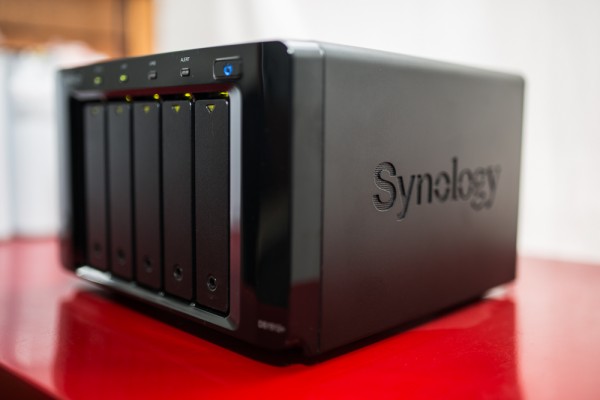 It is no secret that DigitalReviews is a big fan of Synology products. We have reviewed a number of their Networked Attached Storage over the past few years and have always been a fan. This time around Synology has kindly supplied a DS-1512+ for a review with a different focus.
It is no secret that DigitalReviews is a big fan of Synology products. We have reviewed a number of their Networked Attached Storage over the past few years and have always been a fan. This time around Synology has kindly supplied a DS-1512+ for a review with a different focus.
Introduction
Recently I had an opportunity to work with a (real) photographer who was contemplating a move from a direct attached storage model to a network attached storage model. He has around 4 TB of photos taken over the years and backed up to direct attached disks. Sime has already done some homework on moving to a NAS and Synology generously supplied a DS-1512+ chassis to see how a photographer and layman would cope being thrown into the deep end.
The Synology DS-1512+ is a 5 bay NAS that is scalable to a whopping 60TB with the help with chassis expansion. Compared to the previous revision of DS-1511+ that “only” scales to 45TB. The facade has not change but the beating heart certainly has.
The DS-1512+ now sports a dual core 2.13 GHz CPU and 1GB DDR3 memory (base) that is expandable to 3GB.
In Use
Beyond a few words of advice on RAID technology and Synology Hybrid RAID (SHR), I deliberately threw Sime off the deep end when it came to getting the unit up to speed. Sure he has a technology background but those days are buried in his dark history. In his final stand up configuration he filled the 5 bays with:
2 x 2TB Western Digital WD20EARS
2 x 2TB Seagate ST200DCM001
1 x 1TB Seagate ST31000340NS
It is about as mixed a bag as you can get.
With that set of disks I recommended RAID across the four 2TB drives and leave the recycled 1TB drive as a standalone at this point as a scratch disk.
I did keep an virtual eye on things as Sime dived into the Synology. Yes mate, Big Brother is watching to the point were at the end of the first day, I asked if his array initialisation has reached 15% yet (it was at 14.74% at the time). Like all previous Synology NAS the disk array is available to write almost immediately, but performance on disk would be impacted for both IO operations and the initialisation process which ultimately took a bit over a day.
More importantly though for someone who has relied solely on direct attached storage previously, Sime was able to setup and manage the DS-1512+ in less than half an hour. This includes unpacking the NAS, connecting to it to the network via the Airport Extreme , installing DiskStation Manager 4.1 (DSM software), setting up the RAID set, disk shares, creating user accounts, connectivity from his Macbook and ready to migrate his data into the NAS. That is a high vote of confidence on the ease of use of the DSM.
Workflow
In the dark age of direct attached storage, Sime used to manually sync his hard disks for back up purposes. Tedious, manual and prone to errors. By having a NAS on the network, all he has to do is to configure Adobe Lightroom to make a second copy to a specified shared folder on the DS-1512+.
Why the second copy? Well he does have a firewire drive that serves as the primary copy. The RAID protection on the DS-1512+ makes it a safe secondary copy. And what are we always taught do to? Never put all your eggs in one basket. With DSM you could backup from one DiskStation to another (or an Rsync compatible server).
Other Features
All the Synology NAS support plenty of add-on packages which are available via the DSM interface (or the Synology website). What is a creative person going to do when they are editing photos? Stream music of course! With the iTunes server installed Sime serves iTunes content out across his network to iTunes clients, that is on top of sharing his media out to any devices on his network including an Android DTV box.
And on the topic of eggs in one basket, I am personally looking forward to DSM 4.2 and its ability to direct backup to Amazon Glacier. Not only does that mean I will have local copies of my most important files, it will also be directly upload from the NAS into the cloud for long term archival.
The DS-1512+ can be scaled up to 15 drive via eSATA using the Synology DX510/DX513 chassis. IO performance is rated at 194.83 MB/sec writing and 200.31 MB/sec reading.
Specifications
CPU: dual core 2.13 GHz
Memory: DDR3 1GB, expandable up to 3GB
Internal HDD/SSD bays: 5
Max internal raw capacity: 20TB (5 x 4TB HDD)
External interface: 2 x USB 3.0 ports, 4 x USB 2.0 ports, 2 x eSATA ports
Size: 157 x 248 x 233 mm (HxWxD)
Weight: 4.25 kg
LAN: 2 x Gigabit with link aggregation and Wake on LAN/WAN, optional wireless dongle
Conclusions
While this is a less technical review than usual for DigitalReviews, it highlights for the average person just how easy and useful it was for someone to transition to a Synology NAS. Here are the main reasons Sime came up with after using the Synology DS-1512+ for a month: OS agnostic, run value-added features such as WordPress, ease of upgrade of disk capacity, it just works.
The Synology DS-1512+ costs around AUD$800 without disks, an international list of resellers is available here. So Sime now that your storage and workflow is all sorted out, high time we start on those photography projects we have been talking about? In Sime’s own words his experience is documented here.


